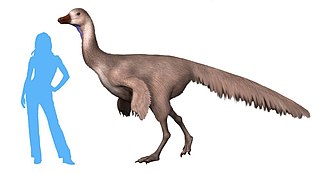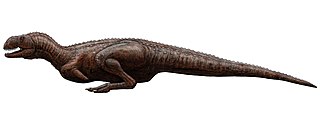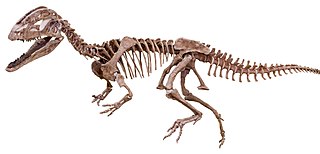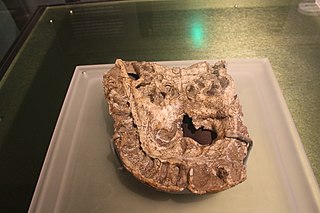
Allosaurus is an extinct genus of large carnosaurian theropod dinosaur that lived 155 to 145 million years ago during the Late Jurassic period. The name "Allosaurus" means "different lizard", alluding to its unique concave vertebrae. It is derived from the Greek words ἄλλος and σαῦρος. The first fossil remains that could definitively be ascribed to this genus were described in 1877 by famed paleontologist Othniel Charles Marsh. The genus has a very complicated taxonomy and includes at least three valid species, the best known of which is A. fragilis. The bulk of Allosaurus remains have come from North America's Morrison Formation, with material also known from the Lourinhã Formation in Portugal. It was known for over half of the 20th century as Antrodemus, but a study of the abundant remains from the Cleveland-Lloyd Dinosaur Quarry returned the name "Allosaurus" to prominence. As one of the first well-known theropod dinosaurs, it has long attracted attention outside of paleontological circles.

Dilophosaurus is a genus of theropod dinosaurs that lived in what is now North America during the Early Jurassic, about 186 million years ago. Three skeletons were discovered in northern Arizona in 1940, and the two best preserved were collected in 1942. The most complete specimen became the holotype of a new species in the genus Megalosaurus, named M. wetherilli by Samuel P. Welles in 1954. Welles found a larger skeleton belonging to the same species in 1964. Realizing it bore crests on its skull, he assigned the species to the new genus Dilophosaurus in 1970, as Dilophosaurus wetherilli. The genus name means "two-crested lizard", and the species name honors John Wetherill, a Navajo councilor. Further specimens have since been found, including an infant. Fossil footprints have also been attributed to the animal, including resting traces. Another species, Dilophosaurus sinensis from China, was named in 1993, but was later found to belong to the genus Sinosaurus.

Cryolophosaurus is a genus of large theropod dinosaur known from only a single species Cryolophosaurus ellioti, from the early Jurassic of Antarctica. It was one of the largest theropods of the Early Jurassic, with the subadult being estimated to have reached 6–7 metres (20–23 ft) long and weighed 350–465 kilograms (772–1,025 lb).

Arkansaurus is an extinct genus of ornithomimosaurian theropod dinosaur. It lived during the Albian and Aptian stages of the Early Cretaceous. The type and only species is Arkansaurus fridayi.
Coelurus is a genus of coelurosaurian dinosaur from the Late Jurassic period. The name means "hollow tail", referring to its hollow tail vertebrae. Although its name is linked to one of the main divisions of theropods (Coelurosauria), it has historically been poorly understood, and sometimes confused with its better-known contemporary Ornitholestes. Like many dinosaurs studied in the early years of paleontology, it has had a confusing taxonomic history, with several species being named and later transferred to other genera or abandoned. Only one species is currently recognized as valid: the type species, C. fragilis, described by Othniel Charles Marsh in 1879. It is known from one partial skeleton found in the Morrison Formation of Wyoming, United States. It was a small bipedal carnivore with elongate legs.

Indosuchus is a genus of abelisaurid dinosaur from the Late Cretaceous Period, a theropod related to Abelisaurus. Like most theropods, Indosuchus was a bipedal carnivore. It was about 7 metres long, weighed about 1.2 tonnes, and had a crested skull, flattened on the top.

Trinisaura is a genus of ornithopod dinosaur that lived during the late Campanian stage of the Upper Cretaceous, around 73 to 72 million years ago in what is now James Ross Island off the coast of northern Antarctica near Patagonia. It is known from a single, incomplete postcranial skeleton that includes several vertebrae, a partial pelvis, and nearly complete right hindlimb. The fossils were collected in 2008 by paleontologists Juan Moly and Rodolfo Coria from the sandstone of the Snow Hill Island Formation. It remained undescribed in the collections of the Museo de La Plata until its description by Coria and colleagues in 2013, being the basis of the novel genus and species Trinisaura santamartaensis. The genus name is to commemorate the efforts of Argentine geologist Trinidad "Trini" Diaz and the Latin root -sauros, meaning "lizard". The species name is after Santa Marta Cove, where the fossils were collected.
Tugulusaurus is a genus of coelurosaurian theropod dinosaur that belongs to the Alvarezsauroidea. It is known from the Early Cretaceous Tugulu Group in the Urhe area of the People's Republic of China. It was one of the first members of Alvarezsauria ever discovered.

Sinosaurus is an extinct genus of theropod dinosaur which lived during the Early Jurassic Period. It was a bipedal carnivore similar to Dilophosaurus, with proportionally large limbs to its slender body. Fossils of the animal were found at the Lufeng Formation, in the Yunnan Province of China.

Antarctopelta is a genus of ankylosaurian dinosaur, a group of large, quadrupedal herbivores, that lived during the Maastrichtian stage of the Late Cretaceous period on what is now James Ross Island, Antarctica. Antarctopelta is the only known ankylosaur from Antarctica and a member of Parankylosauria. The only described specimen was found in 1986, the first dinosaur to be found on the continent, by Argentine geologists Eduardo Olivero and Robert Scasso. The fossils were later described in 2006 by paleontologists Leonardo Salgado and Zulma Gasparini, who named the type species A. oliveroi after Olivero.

Marshosaurus is a genus of medium-sized carnivorous theropod dinosaur, belonging to the family Piatnitzkysauridae, from the Late Jurassic Morrison Formation of Utah and possibly Colorado.

Dracovenator is a genus of neotheropod dinosaur that lived approximately 201 to 199 million years ago during the early part of the Jurassic Period in what is now South Africa. Dracovenator was a medium-sized, moderately-built, ground-dwelling, bipedal carnivore, that could grow up to an estimated 5.5–6.5 metres (18–21 ft) in length and 250 kilograms (550 lb) in body mass. Its type specimen was based on only a partial skull that was recovered.

The Hanson Formation is a geologic formation on Mount Kirkpatrick and north Victoria Land, Ross Dependency, Antarctica. It is one of the two major dinosaur-bearing rock groups found on Antarctica to date; the other is the Snow Hill Island Formation and related formations from the Late Cretaceous of the Antarctic Peninsula. The formation has yielded some Mesozoic specimens, but most of it is as yet unexcavated. Part of the Victoria Group of the Transantarctic Mountains, it lies below the Prebble Formation and above the Falla Formation. The formation includes material from volcanic activity linked to the Karoo-Ferar eruptions of the Lower Jurassic. The climate of the zone was similar to that of modern southern Chile, humid, with a temperature interval of 17–18 degrees. The Hanson Formation is correlated with the Section Peak Formation of the Eisenhower Range and Deep Freeze Range, as well as volcanic deposits on the Convoy Range and Ricker Hills of southern Victoria Land. Recent work has successfully correlated the Upper Section Peak Formation, as well unnamed deposits in Convoy Range and Ricker Hills with the Lower Hanson, all likely of Sinemurian age and connected by layers of silicic ash, while the upper section has been found to be Pliensbachian, and correlated with a greater volcanic pulse, marked by massive ash inputs.

Glacialisaurus is a genus of sauropodomorph dinosaur from the Early Jurassic period of Antarctica. It is known from two specimens; the holotype, a partial tarsus (ankle) and metatarsus, and a partial left femur. The fossils were collected by a team led by paleontologist William R. Hammer during a 1990–91 field expedition to the central region of the Transantarctic Mountains. They come from sedimentary rocks of the Hanson Formation and date to the Pliensbachian stage of the Early Jurassic, around 186 to 182 million years ago. The fossils were described in 2007, and made the basis of the new genus and species Glacialisaurus hammeri. The genus name translates as “icy” or "frozen lizard”, and the specific name honors Hammer.

Kryostega is a large temnospondyl amphibian from the Early or Middle Triassic of Antarctica. The genus is based on a single specimen collected in 1986 by a team led by paleontologist William H. Hammer of Augustana College, and now housed in the collections of the American Museum of Natural History.

Trinisaura is a genus of ornithopod dinosaur that lived during the late Campanian stage of the Upper Cretaceous, around 73 to 72 million years ago in what is now James Ross Island off the coast of northern Antarctica near Patagonia. It is known from a single, incomplete postcranial skeleton that includes several vertebrae, a partial pelvis, and nearly complete right hindlimb. The fossils were collected in 2008 by paleontologists Juan Moly and Rodolfo Coria from the sandstone of the Snow Hill Island Formation. It remained undescribed in the collections of the Museo de La Plata until its description by Coria and colleagues in 2013, being the basis of the novel genus and species Trinisaura santamartaensis. The genus name is to commemorate the efforts of Argentine geologist Trinidad "Trini" Diaz and the Latin root -sauros, meaning "lizard". The species name is after Santa Marta Cove, where the fossils were collected.

Megapnosaurus is an extinct genus of coelophysid theropod dinosaur that lived approximately 188 million years ago during the early part of the Jurassic Period in what is now Africa. The species was a small to medium-sized, lightly built, ground-dwelling, bipedal carnivore, that could grow up to 2.2 m (7.2 ft) long and weigh up to 13 kg (29 lb).

Imperobator is a genus of probable unenlagiid paravian theropod dinosaurs, that lived during the Maastrichtian age of the Late Cretaceous in what is now James Ross Island in Antarctica. Imperobator is one of only two non-avian theropods known from Antarctica, crossing over to the landmass when it was part of Gondwana. The only described specimen was found in 2003 by an expedition launched by the University of California Museum of Paleontology and initially described as a dromaeosaur in 2007. The fossil was formally described as a new genus in 2019, and later searches reported more fossils from the site including teeth and skull bones.















